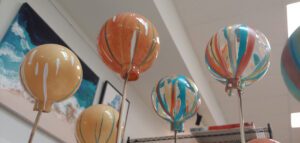 Artist and art enthusiasts were struck hard when COVID hit, with live performances and other displays of art closed down. Over the months, creative thinkers found ways to offer something to the public, but it wasn’t quite the same. This article shares how both performing and visual arts have moved on in 2021.
Artist and art enthusiasts were struck hard when COVID hit, with live performances and other displays of art closed down. Over the months, creative thinkers found ways to offer something to the public, but it wasn’t quite the same. This article shares how both performing and visual arts have moved on in 2021.
PRINCETON SYMPHONY ORCHESTRA AUDIENCES & MUSICIANS CRAVE LIVE MUSIC NOW!
Carolyn Dwyer
What does our community want now? Music. Correction, live music! For most, the pandemic is like a dissonant chord that just won’t quit – it’s annoying and soul-draining. To combat it, Princeton Symphony Orchestra (PSO) patrons have resolved to take back their cultural lives with a renewed appreciation for live music.
As Jay Vawter, a former PSO board member and long-time patron of the Princeton arts scene says, “We look forward to attending live music performances in the concert hall again alongside friends and others who appreciate that every concert offers a unique musical experience.” He adds, “We’ve certainly enjoyed the PSO’s outdoor concerts at Morven very much, as it was our first opportunity to comfortably attend a live performance.”
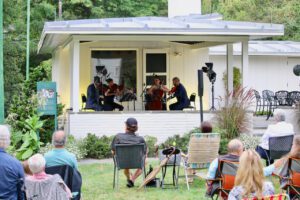 This fall, the PSO offered live performances in and out of the concert hall with attention to health and safety. In September, the PSO’s chamber series returned to the pool house lawn at Morven Museum & Garden with a performance by the superb Jasper Quartet. PSO staff marked out socially distanced seating areas, and masked patrons eagerly lined up to get their digital tickets scanned, lawn chairs and blankets in hand. Some even came early to dine al fresco from home-packed gourmet picnic baskets. The series was back by popular demand after a successful first run last fall and spring.
This fall, the PSO offered live performances in and out of the concert hall with attention to health and safety. In September, the PSO’s chamber series returned to the pool house lawn at Morven Museum & Garden with a performance by the superb Jasper Quartet. PSO staff marked out socially distanced seating areas, and masked patrons eagerly lined up to get their digital tickets scanned, lawn chairs and blankets in hand. Some even came early to dine al fresco from home-packed gourmet picnic baskets. The series was back by popular demand after a successful first run last fall and spring.
PSO trumpet player Tom Cook recalls what it felt like to be among the first to perform following the lock-down. “It was incredible,” he says, “You forget how symbiotic the relationship is between musician and audience. One feeds upon the excitement and enthusiasm of the other.”
More recently, the orchestra returned to performing music indoors at full strength at its October 3rd season-opening concert featuring violinist Simone Porter. The concert marked the orchestra’s first performance in a concert hall since January 2020. While the PSO’s usual home at Princeton University’s Richardson Auditorium remains closed to outside groups (the PSO is a non-profit organization independent of the University), the orchestra has taken up temporary residence at McCarter Theatre Center. Although diehards might prefer their usual subscription seats at Richardson, others are interested in hearing how the orchestra sounds in a different venue.
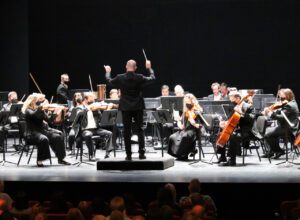 Generally, people want to remain as safe as possible while returning to the concert environment they loved pre-pandemic. Health concerns are allayed by McCarter’s contactless ticket scanning and its stringent mask and proof of vaccination policies. Traditional paper programs are now replaced by digital program books accessed through a QR code scanned with a smartphone. It takes getting used to, people lighting up their phones during a performance –traditionally a no-no. Users are encouraged to keep their devices at a discreet level, a new type of concert etiquette. PSO Executive Director Marc Uys hopes that digital programs are here to stay.
Generally, people want to remain as safe as possible while returning to the concert environment they loved pre-pandemic. Health concerns are allayed by McCarter’s contactless ticket scanning and its stringent mask and proof of vaccination policies. Traditional paper programs are now replaced by digital program books accessed through a QR code scanned with a smartphone. It takes getting used to, people lighting up their phones during a performance –traditionally a no-no. Users are encouraged to keep their devices at a discreet level, a new type of concert etiquette. PSO Executive Director Marc Uys hopes that digital programs are here to stay.
Uys explains, “Every season I think of all the trees destroyed to make program books that most people barely look at before tossing them in the trash heap. I’d like our orchestra to be at the leading edge of a more ecological approach.”
Masks and QR codes, aside, the quality of music performed by the PSO is unchanged. And that’s important to patrons like Mr. Vawter. Whether playing contemporary works like composer Jessie Montgomery’s Banner or accompanying guest artists such as this month’s virtuosic pianist Shai Wosner, the professional musicians of the PSO are kept in top form by Edward T. Cone Music Director Rossen Milanov.
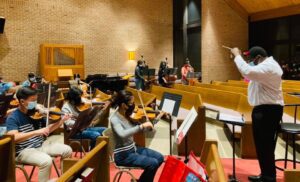 Making music is as important to area youths as it ever was. Recently appointed Assistant Conductor of the Princeton Symphony Orchestra Kenneth Bean gained insight into what live music has meant to the musicians of the Youth Orchestra of Central Jersey’s Symphonic Orchestra. He took on the role of their conductor as an extension of his position with the PSO.
Making music is as important to area youths as it ever was. Recently appointed Assistant Conductor of the Princeton Symphony Orchestra Kenneth Bean gained insight into what live music has meant to the musicians of the Youth Orchestra of Central Jersey’s Symphonic Orchestra. He took on the role of their conductor as an extension of his position with the PSO.
Bean says, “The kids have been playing with one another in an internet vacuum or in parking lots for over a year. They are so excited to be back inside where they can actually hear one another and be fully drawn into the music. It’s not drudgery for these kids. It’s pure joy.”
While it’s thrilling to be experiencing live music indoors at last, the lure of music outdoors in warmer months remains. Having merged over the summer with the Princeton Festival, the PSO is exploring ways to reinvent the June-centered Festival as a semi-outdoor cultural destination extravaganza, complete with its usual array of offerings including opera, cabaret entertainment, early music, lectures, and more. According to Mr. Uys, “We are doing everything possible to ensure that the performing arts continue to thrive in Princeton.”
In the end, everyone from patrons to musicians wants to keep the live performing arts going in Princeton. Patrons find it worth the hurdles of wearing masks, standing in line with photo IDs and proof of vaccination, and managing the, for some, new technology involved with digital programs. They remain attracted to what they’ve always loved – moments of transport through the medium of exquisite live music!
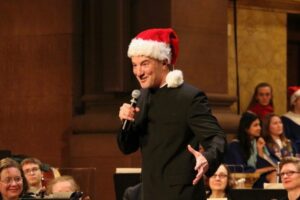 The Princeton Symphony Orchestra plans to return to its home venue of Richardson Auditorium at Princeton University this spring. Princeton Symphony Orchestra’s next performance is the annual Holiday POPS! concert on Tuesday, December 14 at 7:30pm at McCarter’s Matthews Theatre.
The Princeton Symphony Orchestra plans to return to its home venue of Richardson Auditorium at Princeton University this spring. Princeton Symphony Orchestra’s next performance is the annual Holiday POPS! concert on Tuesday, December 14 at 7:30pm at McCarter’s Matthews Theatre.
VISUAL ARTS THRIVE IN OLD AND NEW SPACES
Jim Levine
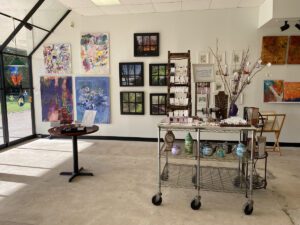 “I’m always blown away by the variety of artistic expression.” Hearing this statement from a customer, while sitting in my studio at Princeton Makes, was music to my ears. It expresses one of the goals of Princeton Makes – to give an outlet to a wide variety of local artists – and could just have easily been said about the greater-Princeton area. Princeton is home to a huge array of artists, from major names exhibiting widely to lesser-known creators who exhibit locally. Prior to joining the Board of Directors of the Arts Council of Princeton I had limited awareness about the arts community in Princeton. I knew of the major art institutions – the Arts Council, McCarter, the Princeton University Art Museum among others – but I really didn’t know the full extent of artmaking in the area. As a Board member, my awareness increased. But when I became the Interim Director, I really came to realize the breadth and depth of the vibrant arts community in Princeton.
“I’m always blown away by the variety of artistic expression.” Hearing this statement from a customer, while sitting in my studio at Princeton Makes, was music to my ears. It expresses one of the goals of Princeton Makes – to give an outlet to a wide variety of local artists – and could just have easily been said about the greater-Princeton area. Princeton is home to a huge array of artists, from major names exhibiting widely to lesser-known creators who exhibit locally. Prior to joining the Board of Directors of the Arts Council of Princeton I had limited awareness about the arts community in Princeton. I knew of the major art institutions – the Arts Council, McCarter, the Princeton University Art Museum among others – but I really didn’t know the full extent of artmaking in the area. As a Board member, my awareness increased. But when I became the Interim Director, I really came to realize the breadth and depth of the vibrant arts community in Princeton.
It’s an interesting time for art in Princeton, as the closing of the Princeton University Art Museum for reconstruction has taken away a much-treasured place for viewing artwork. Two things are helping to fill the void. The Art Museum has worked to enliven empty storefronts by displaying some of their work in large format and the Arts Council continues its long tradition of showing a wide array of work from local and regional artists in its Taplin Gallery. Public reaction to and interaction with the work at the Arts Council has heightened during the Art Museum’s reconstruction.
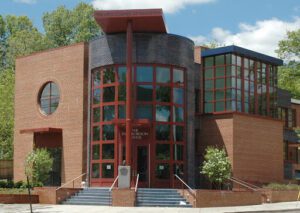 One of the main missions of the Arts Council is to promote local artists. This is carried out in many ways, including offering an enormous variety of classes for artists at all levels, providing gallery space for artists to display their work, hosting events where artists can sell their work, and maintaining updated information about resources for artists. Despite these efforts, there were still local artists who looked for more from the Arts Council, often beyond the organization’s resources to provide. From first-hand experience, I can definitely say it was not from a lack of interest or desire.
One of the main missions of the Arts Council is to promote local artists. This is carried out in many ways, including offering an enormous variety of classes for artists at all levels, providing gallery space for artists to display their work, hosting events where artists can sell their work, and maintaining updated information about resources for artists. Despite these efforts, there were still local artists who looked for more from the Arts Council, often beyond the organization’s resources to provide. From first-hand experience, I can definitely say it was not from a lack of interest or desire.
Two areas that were frequently cited were the lack of studio space and ongoing retail space. And thus, after my interim assignment ended and I had some success selling my stained glass at the Sauce for the Goose holiday market, I came up with the idea for Princeton Makes. With the support of the Princeton Shopping Center, Princeton Makes was able to open in September and offer studio space and a dedicated retail space for local artists. The response from the local arts community has been fantastic. We now have 12 artists working in the studios, and the store hosts the work of those 12 artists along with an additional 20 artists who don’t need studio space but are looking for an outlet to sell their art. Even with these numbers, there are countless other artists who would love to have similar opportunities – well beyond the capacity of Princeton Makes to serve.
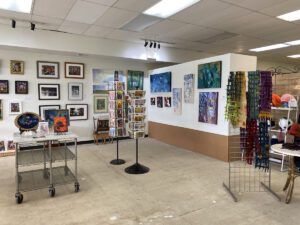 I see Princeton Makes as a great complement to the Arts Council by providing services to artists that the Arts Council can’t. And yet there are even more needs. Princeton should have more gallery and studio space, better avenues for artists to interact, and increased retail space. The Arts Council has done an outstanding job of increasing the prevalence of public art, but there are still lots of opportunities to better integrate local art into the community.
I see Princeton Makes as a great complement to the Arts Council by providing services to artists that the Arts Council can’t. And yet there are even more needs. Princeton should have more gallery and studio space, better avenues for artists to interact, and increased retail space. The Arts Council has done an outstanding job of increasing the prevalence of public art, but there are still lots of opportunities to better integrate local art into the community.
The success of Princeton Makes ultimately will be decided by the Princeton community. We hope to become a go-to place when looking for art, crafts, and gifts. The initial reaction from the public has been very positive. “This is just what the community needs,” has been heard over and over again as people stroll through the space and talk with the artists working in their studios or staffing the store.
I’m always struck by the resourcefulness of local artists. Making a full time living in the arts is not easy, so artists branch out. They teach, they take commissions, they sell cards and prints of their work. In short, they do whatever they need to do so that they can continue to fulfill their innate need to make art. It is truly impressive. The vibrancy of the arts in Princeton will continue to flourish when everyone in the community recognizes and embraces the value that the artist community brings to our lives and makes every effort to support it with their time, attendance, participation, and purchases.
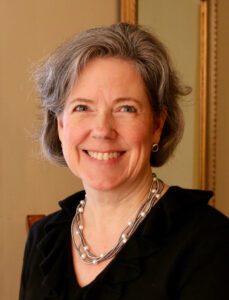 Carolyn Dwyer is manager of marketing and communications for the Princeton Symphony Orchestra (PSO) and has been with the orchestra since 2013. She graduated with a BA in English from the College of the Holy Cross, and is a long-time Princeton resident. The Princeton Symphony Orchestra (PSO) is a cultural centerpiece of the Princeton community and one of New Jersey’s finest music organizations. Led by Edward T. Cone Music Director Rossen Milanov, the PSO presents orchestral, pops, and chamber music programs of the highest artistic quality.
Carolyn Dwyer is manager of marketing and communications for the Princeton Symphony Orchestra (PSO) and has been with the orchestra since 2013. She graduated with a BA in English from the College of the Holy Cross, and is a long-time Princeton resident. The Princeton Symphony Orchestra (PSO) is a cultural centerpiece of the Princeton community and one of New Jersey’s finest music organizations. Led by Edward T. Cone Music Director Rossen Milanov, the PSO presents orchestral, pops, and chamber music programs of the highest artistic quality.
 Jim Levine spent 28 years in Human Resources Management at FMC and Church & Dwight. After leaving the Corporate world, he taught high school and college for a couple years, before serving as Interim Executive Director of the Arts Council of Princeton for two years. After a Permanent Director was named in September, 2021, Jim spent time making stained glass artwork while considering how to build a community of artists in the Princeton area. This past spring the idea for Princeton Makes was developed and the cooperative opened in September. Jim and his wife Lisa raised three children, Zeke, Freddie, and Elijah, in Princeton. Jim is also on the Board of Ultimate Peace, an organization that uses the sport of Ultimate Frisbee to develop bridges of peace between Palestinian and Jewish youth living in Israel.
Jim Levine spent 28 years in Human Resources Management at FMC and Church & Dwight. After leaving the Corporate world, he taught high school and college for a couple years, before serving as Interim Executive Director of the Arts Council of Princeton for two years. After a Permanent Director was named in September, 2021, Jim spent time making stained glass artwork while considering how to build a community of artists in the Princeton area. This past spring the idea for Princeton Makes was developed and the cooperative opened in September. Jim and his wife Lisa raised three children, Zeke, Freddie, and Elijah, in Princeton. Jim is also on the Board of Ultimate Peace, an organization that uses the sport of Ultimate Frisbee to develop bridges of peace between Palestinian and Jewish youth living in Israel.
